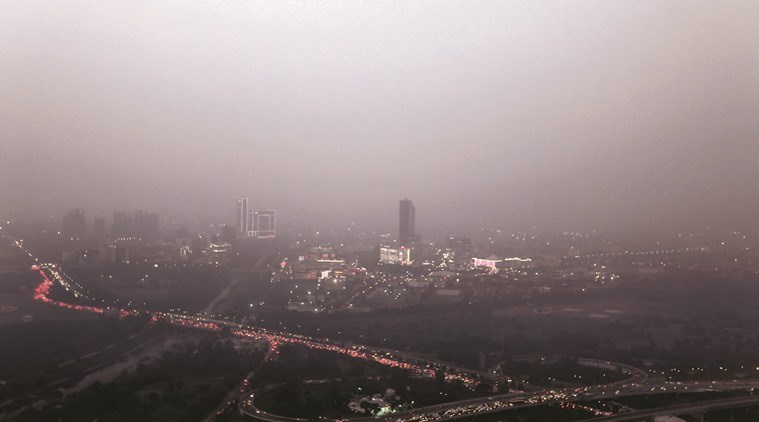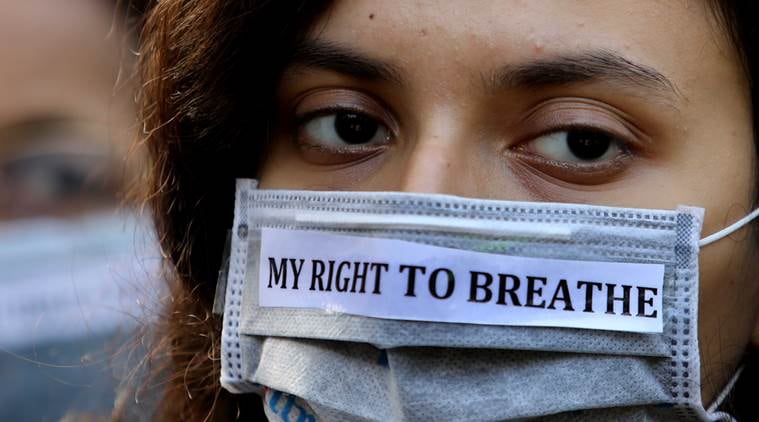Smog, that appears as a thick haze with a brownish tint, is mostly caused by high concentrations of nitrogen oxides.

The air quality in Delhi-NCR plummeted to ‘severe’ in the days following Diwali as major pollutants were recorded as — PM 2.5 at 500 (severe) and PM 10 at 486 (very poor) — in the city’s Lodhi Road area, according to the Air Quality Index (AQI) data. The deteriorating air quality has been aided by winter setting in, and stubble burning picking up in neighbouring states like Punjab and Haryana. On Tuesday, five cities — Ghaziabad, Noida, Greater Noida, Muradabad, and Panipat — recorded ‘severe’ levels of air pollution with an AQI of more than 400, as per Central Pollution Control Board (CPCB).
In India, AQI value from 201 to 300 is categorised as ‘poor’; 301-400 as ‘very poor’; and 401-500 as ‘severe’.
On Wednesday at 11 am, Wazirpur Industrial Area recording an AQI at 486, followed by Ghaziabad at 420, Anand Vihar at 406, Dwarka at 385 and ITI Jahangirpuri at 358.
Weather forecast today LIVE UPDATES: IMD forecast extremely heavy rains in Lakshadweep, issues red alert for two days
Smog, that appears as a thick haze with a brownish tint, is mostly caused by high concentrations of nitrogen oxides. India’s Ministry of Earth Sciences published a research paper in October 2018 attributing almost 41 per cent of PM2.5 air pollution in Delhi to vehicular emissions, 21.5 per cent to dust and 18 per cent to industries. Largely, the result of industrial and road traffic pollution, nitrogen oxides react with hydrocarbons in sunlight to form ozone, which then mixes with air particles to form thick haze.
As per the Environmental Protection Agency (EPA), it can be dangerous to breathe in too much smog as it contains a pollutant called ozone, and elevated ozone levels can have a variety of negative effects on your lungs. A combination of construction dust, open burning, incinerators, auto exhaust and other pollutants comprise smog that can have serious repercussions.
Anyone who engages in strenuous outdoor activity, from jogging to manual labour, is prone to smog-related health hazards. Since physical activity causes people to breathe faster and more deeply, it exposes their lungs to more ozone and other pollutants.
As per experts, four groups of people are particularly sensitive to ozone and other air pollutants in smog. These are children who spend a lot of time outdoors – especially children with asthma, healthy adults who exercise outdoors or spend a lot of time in the sun, people with allergies or sensitive to changes in the environment, and the elderly. Even people who commute to work in their cars are not protected.
In fact, the CPCB says that severe levels of pollution can affect even healthy people and seriously affect those with existing diseases.
Air pollution killed 1.2 million people in India in 2017, says report; bigger killer than smoking
Check for these signs
“In India, a 30 per cent to 40 per cent increase in the cases of wheezing, respiratory diseases, exacerbation of bronchial asthma, and bronchitis patients of all ages and gender were reported during the Diwali festival, and this accentuated in children with asthma,” said Dr Srikanta J T consultant- paediatric pulmonology, Aster RV Hospital.
Smog will make it harder to breathe; it will irritate your lungs and airways, and will worsen chronic diseases such as heart disease, chronic bronchitis, emphysema and asthma.
Since air pollution can be harmful to your health, even when a smog alert isn’t issued, it is important to watch out for the following signs:

1. Breathing difficulties – If you have breathing problems, contact your healthcare professional immediately
2. Chest tightness
3. Cough or throat irritation
4. Eye irritation
5. Light-headedness
6. Wheezing
7. Rhinitis, sneezing, sinusitis
8. Skin rashes, dryness, itching
9. Bronchitis, laryngitis, dry cough
The dangers of air pollution: What you need to know about Delhi smog
Here’s how to protect yourself
*Check the AQI in your locality.
*People should wear or carry quality air masks with them at all times. “Using masks, particularly N95, to cover the nose and mouth is also advisable as this can effectively prevent inhalation of smoke and harmful metals,” explained Dr Srikanta.
*Limit strenuous outdoor activities, when the AQI is high.
*Avoid exercising near areas of heavy traffic.
*The atmospheric pollution can cause irritation on the skin too. “Get your skin cleansed. Meet a doctor in case of any skin irritation. Drink at least 8-10 glasses of water a day to keep your skin hydrated,” he added.
*According to Dr Saurabh Arora, inventor SNEC30, Arbro Pharmaceuticals, turmeric is known to provide relief from the effects of smog, which he says can lead to depression (in some individuals) if not treated. He said, “Curcumin (which is found in turmeric) is one of the best natural anti-inflammatory and antioxidant agent that helps in combating inflammation of bronchial tubes. It helps to fight microbial infections associated with bronchitis and develop immunity against it.”
Source: Read Full Article
